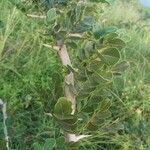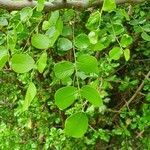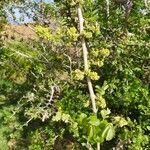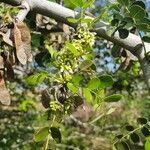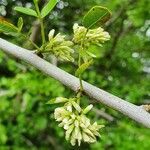Spiny shrub or tree, up to 5-12(-30) m tall, typically several stemmed and much branched to form a low irregularly shaped crown; bark grey, ultimately rough and fissured or flaking; heartwood purplish-brown to black. Branchlets clustered at the nodes, some growing out, others relatively short and spine-tipped, covered at first with short crisped hairs, but usually soon glabrescent. Leaves mostly 6-22 cm long; stipules oblong-ovate or oblong, 2-6 mm long, fugaceous; lateral leaflets 4-6(-8) on either side of rhachis, mostly oblong-obovate to obovate, 1-5(-5.5) cm long, 0.7-3(-5) cm wide, truncate or emarginate at apex, broadly cuneate to rounded or slightly cordate at base, shortly pubescent at least beneath, glabrescent; primary lateral nerves 8-12 on either side of midrib, the lower ones ascending to upper half. Panicles appearing with flush of new leaves, ±3-12 cm long, laxly branched, many-flowered, with slender subglabrous to shortly crisped-pubescent axes; bracts linear-lanceolate to ovate, concave, 0.5-1 mm long, caducous; bracteoles at top of short pedicel similar. Calyx 2-3(-4) mm long, sparsely pubescent to subglabrous except on margins. Corolla 4-6 mm long, white, fragrant; standard elliptic-obovate or obovate, narrowed to claw; wings little shorter than standard and slightly exceeding keel. Stamens usually 9, united or variously divided. Fruit elliptic-oblong or irregularly oblong, bluntly pointed, with the 0.5-1 cm long stipe 3-7 cm long, 0.8-1.4 (-2) cm wide, papery, glabrous, laxly and rather diffusely veined, 1-2-seeded.
A climber. It can be a shrub or straggling tree. It grows 10 m high. It has many branches and many spines. The crown is irregular. The bark is rough and grey. It flakes off in small scales. The leaves are 8-20 cm long. There are 6-12 leaflets. The are 1-4 cm long by 1-3 cm wide and almost round. The group of flowers are in the axils of leaves or at the ends of branches. They can be 8 cm long. The flowers are white and have a sweet scent. They are small. The fruit is a 1-3 seeded pod. It is 3-7 cm long by 1-2 cm wide. It is thin and stiff and has lumps over the seeds. There are 8-10 seeds. They are 7-8 mm long by 1.5 mm wide. They are reddish-brown and glossy.
Leaves 8–20 cm long; petiole 1.5–5 cm long, rachis 4–13 cm long; petiolules 1.5–2 mm long; leaflets 6–12 or more, 1–3.5 × 1–2.5 cm, circular to broadly elliptic or obovate or subspathulate, rounded to truncate and often emarginate or retuse at the apex, rounded or slightly cordate or cuneate at the base; lateral nerves scarcely visible; stipules 2.5–5 mm long, caducous.
Standard 3.5–4.5 mm long, broadly obovate, emarginate or retuse, claw c.1 mm long; wings oblong-obovate, claw c.1.5 mm long; keel petals shorter and broader than the wings, dorsally slightly connate or free.
Inflorescence of axillary and terminal panicles 2.5–8 cm long, usually borne on reduced short, spine-tipped shoots; bracts and bracteoles c.1 mm long, usually present at anthesis.
Shrub or straggling tree up to c.10 m high, much-branched, with spines derived from modified shoots; crown irregular; bark rough, greyish, flaking off in small scales.
A small tree up to 20 ft. high, much-branched, glabrous, armed with woody spines which are the hardened tips of short branches often bearing leaves and flowers
Calyx 2.5–3 mm long, slightly puberulous; upper teeth shallow and rounded, the lateral ones rounded, the lower one triangular-acute and longer than the rest.
Stamens 9 in a single bundle, the upper one free or absent, or fused in 2 bundles of 5.
Pod 1–3-seeded, 2.5–7 × 1–1.8 cm, thin, stiff, conspicuously reticulate over the seeds.
Young parts minutely crisped-puberulous, soon glabrous; bark smooth and pale grey.
Flowers white, sweet-scented, 3.5–5 mm long, secund; pedicels 1–3 mm long.
Ovary 2–4-ovulate, puberulous; style short, oblique, stipe c.1.5 mm long.
Seed 8–10 × 7–8 × 1.5 mm; testa reddish-brown, glossy.
